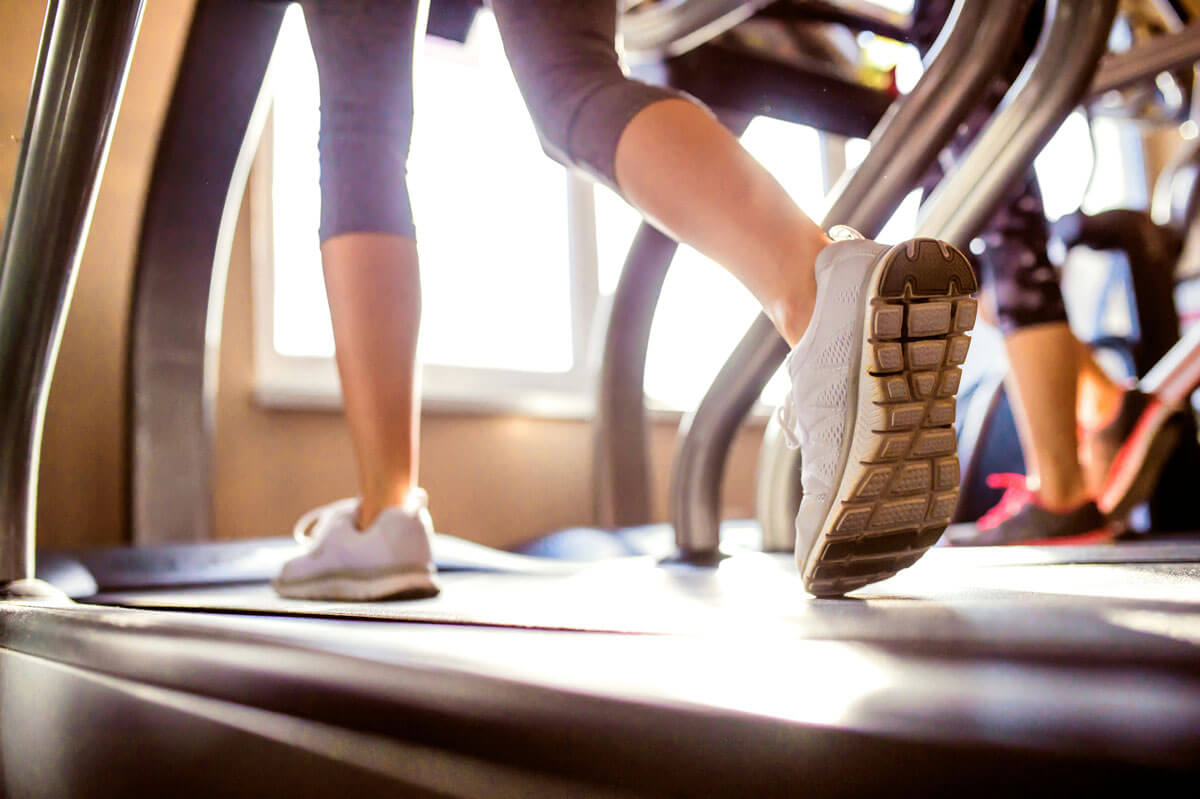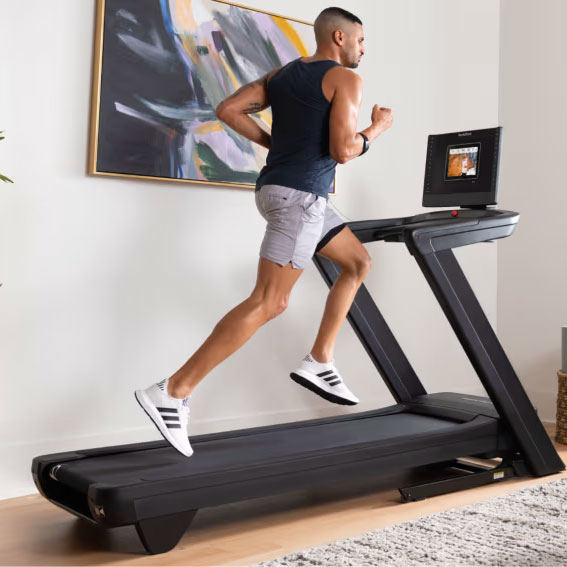Running on treadmill vs. running outside: Everything you need to know

Few running debates are as hotly contested as the conversation about running on a treadmill vs. outside. Both forms of cardio have their perks, but it’s natural to wonder if one is superior over the other, providing a better workout or the ability to get you fitter, faster.
As with most controversial running questions — like which foot strike is best, and whether or not super shoes actually make you faster — there are plenty of strong opinions about both outdoor running and treadmill running. For example, some may say running outside is unsafe, while others have given treadmills the harsh nickname, ‘the dreadmill.’
Running on a treadmill and running outside can both give you a great workout, but there are differences in how the two versions of running challenge your body, according to Rachel Tavel, PT, DPT, CSCS, a physical therapist and certified strength and conditioning specialist. Depending on your training regime and long-term goals, one option may be better for you.
To help you decide between running on a treadmill vs. outside, we broke down the pros and cons of each.
Pros and cons of treadmill running
Treadmills provide a controlled environment
Running on a treadmill eliminates weather elements like wind resistance, rain, humidity, air quality and excessive heat — all of which can increase the demand of your workout, affecting your ability to run or run well, Tavel explains. The convenience of eliminating environmental factors make the treadmill an ideal way to train during inclement weather like snowstorms on the East Coast, fire season on the West Coast, and brutal summers in the South.
Treadmills are convenient and safe overall
In addition to being able to bring your run indoors due to dangerous weather conditions, like thunderstorms, ice, or excessive heat, a treadmill eliminates the need to map out a running route ahead of time or dress appropriately for the weather conditions. Running on a treadmill in the early morning or evening when it’s dark is arguably safer compared to running outdoors, where you’re susceptible to traffic, wildlife, and other potentially dangerous threats.

Treadmills have adjustable settings
Treadmills give runners the autonomy to adjust their pace and incline gradient, making it easy to incorporate interval training or a hill workout at the ready. Being able to customize your workout is also helpful when training for a race with a specific pace goal, or particularly hilly race course.
Treadmills decrease the impact on your joints
Treadmills generally have a softer surface texture designed to help with shock absorption during impact, or the moment your foot hits the ground, Tavel explains:
“Different treadmills do this to a different degree, but the effect can reduce the overall ground impact force on joints compared to running on harder outdoor surfaces like pavement or concrete.”
Research backs this up: A 2020 study found that running on a treadmill averaged 71.3 percent more shock absorption compared to running on asphalt. Another study found a correlation between treadmill running and reduced bone strain compared to running outdoors on harder surfaces. In general, loading our bones is healthy and helps build bone mass (especially before age 30), but someone returning to running after a stress fracture or bone injury may benefit from alternating road runs with treadmill runs as they build their mileage to decrease the overall impact on their joints.

Treadmills provide less energy return
The treadmill’s softer surface texture may decrease the impact on your joints, but it also limits the amount of energy returned as your foot hits the ground, increasing the work for your muscles overall. The same 2020 study mentioned previously found that the energy return of treadmill running was just 37 percent, compared to 90 percent with asphalt running.
Think about running on a beach: With each step, you sink into the ground, making it more difficult to advance forward. To a lesser degree, the treadmill is like a sandy beach. It absorbs impact, but doesn’t do a great job returning it to you for the next step.
Treadmills require less effort
The limited energy return associated with treadmill running is directly counterbalanced by the propulsion of the moving belt. Treadmill belts are constantly moving under a runner’s feet assisting them with forward propulsion.This decreases the demand on your musculoskeletal and cardiovascular system.
“Instead of a runner having to push off the ground to create a forward movement [when running outdoors], someone running on a treadmill just has to lift off the belt and allow it to move to create a similar sensation or feeling of forward movement,” Tavel explains.
Treadmills have very little variability
A major critique of treadmills is that there’s very little variability unless you purposely incline the treadmill or vary your speed, according to Elizabeth Poppert, PT, DPT, MSC, OCS, a physical therapist and adjunct associate professor at the University of Southern California. Treadmills also don’t allow runners to turn, or run downhill. This can decrease your body’s adaptability, leaving you more susceptible to injury.
Treadmills make you feel like you’re working harder than you are
Most people can relate to this: Running on a treadmill somehow just feels harder compared to running outside. There’s actual scientific evidence to back this up: A 2019 systematic review found that preferred running speed — or the speed people choose when they’re told to run at a self-selected pace — was slower on a treadmill compared to running outdoors. The same review also found that as running speeds increased, heart rate and perceived effort were higher on the treadmill compared to running outside.
While we’d expect the lack of air resistance and propulsion of the treadmill belt to make a treadmill effort feel less taxing, the lack of familiarity with a treadmill or overall lack of stimulation compared to running in a changing environment likely creates a mental hurdle associated with the machine.
Treadmills can be boring
Treadmills have often been compared to neverending hamster wheels in the media, and are consistently critiqued for being boring, which can shrink motivation levels.
“Sometimes it’s less motivating to go into a basement, garage or small room and run on a treadmill, making it less exciting and motivating to adhere to a workout program,” Tavel explains. “It’s also hard to run socially on a treadmill.”
Treadmills aren’t accessible to everyone
While treadmills are convenient, especially during bad weather, they’re not as accessible as grabbing your running shoes and heading outdoors. Tavel points out that you either have or pay for a gym membership to gain access to a treadmill, or pay a hefty cost to have one in your own home. While these are viable options for some, it’s just not an option for everyone.
Treadmills are generally safe (unless you fall off one)
Running on a treadmill is typically safe, but there are still safety risks involved. One study analyzing emergency room visits over 17 years found a significant increase in treadmill-associated head injuries, demonstrating the importance of using the treadmill’s emergency stop safety key feature, and staying aware of your footing throughout your run.
Pros and cons of running outside
Running outside is easily accessible
Part of the reason why running is such a popular sport is its accessibility. For most people, a pair of running shoes is all you need to get started. More than that, running is an activity most people learn as toddlers, making it a familiar movement our bodies can naturally return to.
Running outdoors provides natural variability
Outdoor runners experience variability compared to the monotony of treadmill running. Natural inclines and declines of the road or trail, and navigating curbs and obstacles are all important for joint and tendon loading adaptations, Poppert explains. Acceleration and deceleration, which happen naturally when running outdoors due to the environment around us — like accelerating to finish crossing the street while the ‘walk’ sign is on, are also important for muscle growth and priming our bodies for injury prevention.
“One of the best ways to keep our bodies adapting is variability,” Poppert explains. “The more varied our runs are, the more adaptable we become. The more adaptable we become, the better our bodies are at preventing injuries.”
Running outdoors recruits more muscle activity
Compared to treadmill running, outside running requires individuals to generate all of the forward propulsion themselves, adjusting to wind resistance and terrain changes, Tavel explains. This demands a greater effort from your muscles and your brain, and requires the intrinsic muscles of your feet, calves, quads, hamstrings and glutes to be adaptable as they respond to the demands of the environment like surface texture, incline, and ground traction. Your body also needs to respond to the changing environment and terrain, which can increase the range of muscles used compared to treadmill training.
A 2022 study found that while both treadmill running and running outside improved physical fitness and decreased fat percentage in study participants, outdoor runs better preserved muscle mass and allowed greater physical fitness improvements.
Running outside feels more enjoyable (usually)
A 2019 systematic review found that exercising outdoors was more enjoyable and viewed positively by research subjects compared to indoor physical activity. The fresh air and greater sensory experience provided while outside running compared to running on a treadmill, combined with the positive influence nature can have on our mood, can overall just make for a more enjoyable and interactive run. From changing views, to sounds, to slopes of the sidewalk or road, there’s much more for us to see and for our bodies to react to.
Running outdoors is good for our mental health and well-being
Since outdoor running can be done in nature, outdoor runners get a variety of additional health and wellness benefits beyond working out, like mental health benefits, Tavel reminds us. This can include improved mood , reduced anxiety, and decreased depression risk.
“Running outside can also help one attain important and valuable Vitamin D from the sun, which is extremely important for bone health, among other things [like muscle function and immune health],” Tavel says.

Running outside can be social
While indoor treadmill classes do exist, like at New York City’s Mile High Run Club, it’s rare and more challenging to incorporate any sort of social component into treadmill running. Road running and trail running provides plenty of social opportunities, from simply running with a friend, to joining a running group for a casual run or speed workout. For many, the social component of running is what provides the greatest satisfaction when it comes to their running experience.
Running outside has its safety risks
While running outside is a mental outlet for many and is already incorporated into so many individual’s routines, it can pose some safety threats. From traffic, to potholes in the road, to potential predators (both of the human and animal variety) and even weather threats, it’s important to stay vigilant when running outdoors. Other safety precautions include bringing your phone with you, running with a friend, knowing your route, and letting someone know your whereabouts and expected return time.
Key differences in running mechanics
The treadmill was invented in the 1950s and popularized in the 1960s. Since then, despite the unfavorable nickname and social media hashtag #dreadmill, it’s been a valuable tool for runners and others looking for a decent cardio workout.
While a 2020 study found some kinematic differences at foot strike while running on a treadmill, it concluded that overall, the differences between running on a treadmill and running outdoors are trivial. Poppert warns that it’s important to give treadmill studies that say otherwise a healthy dose of side eye.
“The overall take is that biomechanically, there’s not a significant difference between running on a treadmill vs. running outside,” Poppert explains. “While there’s a smattering of studies available from as early as 1976 about treadmill running, it’s important to remember treadmills were a little bit different back then, and have changed since.”
Additionally, study findings are varied, sample sizes are small, and results of these studies depend on the type of treadmill used, and the speed chosen for the study, which can have a big impact on biomechanics and kinematics.
TL;DR? Don’t overthink it. A run — whether on a treadmill or outdoors — is a run.
What else you should consider
Calorie burn and fitness impact
While studies hint that outdoor running is better for overall physical fitness and some sources claim that running outdoors burns more calories than running on a treadmill, this isn’t always the case. If your goal with running is to simply build your aerobic capacity, improve your cardiovascular fitness, or lose weight, Poppert argues that it doesn’t matter whether you’re on a treadmill or a road — or a bike, for that matter.
“Your body doesn’t know whether you’re on a treadmill or outside,” Poppert explains. “It just knows that you’re doing some large movements with big muscles at a submaximal level, and that your heart needs to pump faster to deliver more blood and oxygen to your muscles.
What actually impacts your overall fitness is the type of workout you choose to do, Poppert says. For example, doing hill sprint repeats on a treadmill is likely going to burn more calories and be more physically demanding than someone running a casual 5k over flat terrain.
Training for specific goals
The best choice between running on a treadmill vs. running outside depends on your personal situation and your running goals. Poppert points to the specificity principle of training, which states that the way the body responds to physical activity is very specific to the activity itself, so your training should relate to your goal as much as possible.
“If you train specifically to run a road marathon, then the majority of your runs should be outdoors,” Poppert explains. “And if you’re training for another event, like a trail run or triathlon, then be specific to that.”
Of course, even if you’re training for a road race, peppering in a treadmill workout here or there due to inclement weather, time constraints, or convenience won’t seriously derail your goals on race day.
Safety and injury prevention
As noted above, there are safety risks with both outdoor running and running on a treadmill. When running on a treadmill, keep yourself safe by utilizing the machine’s safety key, ramping up your speed and incline slowly to avoid trying to keep up with a pace or gradient that’s beyond your limits, and becoming familiar with the ins and outs of the machine before your workout. When running outside, it’s important to wear reflective gear, know your running route, and bring a phone or run with a friend for safety.
When running outside or on a treadmill, it’s crucial to stay mindful (that means running without headphones and paying attention to your surroundings) and to let someone know before you begin your workout, and when you expect to be done.
To prevent injury, build up your mileage conservatively. A good idea is to follow the 10 percent rule, which states you should never increase your weekly mileage by more than 10 percent each week. If you’re just beginning a running regime, a good place to start is by utilizing the run-walk method: Run one minute, walk one minute for 20 minutes total.
Making the right choice for your running needs
Whether you’re more partial to running outside or running on a treadmill, the good news is both avenues will increase your cardiovascular health and improve your fitness.
While a treadmill is a great option to help you stick to your running regime in bad weather, stay safe when fitting in a pre-dawn or after-dusk run, and decrease impact on your joints when returning from injury, it lacks variability, can feel harder than it actually is, and often feels boring. Running outside has greater muscle engagement, improves reactivity ability, and provides health benefits beyond fitness, like boosting your mood and overall enjoyment, but can also be unsafe, especially if running alone or in high-trafficked areas.
Making the choice between running on a treadmill vs. outside largely depends on your individual needs, fitness goals, and personal preferences. The best workout is one that you do regularly, and enjoy — so if you tend to prefer running on a treadmill vs. outside, or vice versa, it’s best to lean in to whatever that is to create a healthy, sustainable routine.

 Published on Mar 12, 2024 by
Published on Mar 12, 2024 by 










